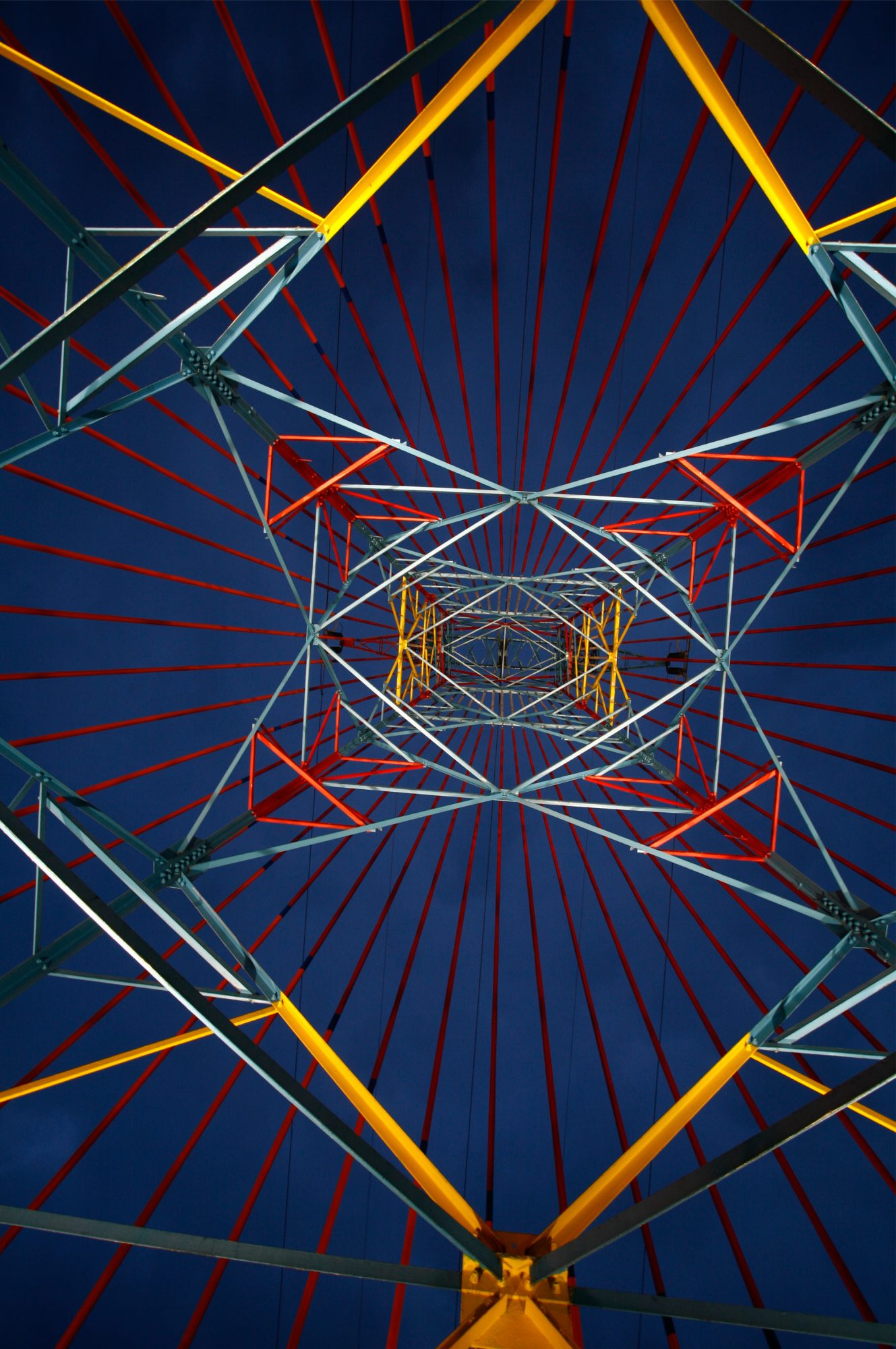Source, a monumental art installation
Four overhead line supports and 1.5 km of line are transformed into artworks.
Key figures
- Sizes: 34m high, 1255m long, 28m wide
- Media: stay-cables, stainless steel tubes, on pylons of a 225,000 volt operating line
- Materials: 3,284m of steel cable, 2,708m of stays, 525m of plastic canvas, 576m of stainless steel tubes, 384 fixations, 40 lighting projectors controlled by satellite
- Inaugurated: February 17th, 2004
- Originator and management: RTE France
Pylons
- 10: “Source – Light” (28m)
- 11: “Source – Water” (28m)
- 12: “Source – Energy” (34m)
- 13: “Source – Flame” (34m)
Location:
- Tourist and Spa Centre
- Amnéville les Thermes, France
- Visitors: more than 5 million a year
Context
At its inauguration in 1950, the 225,000 volt Amnéville-Montois line crossed a former steel mining area in Lorraine. Since, a tourist and thermal centre has been developed around.
In 2003, a convention was signed between RTE and the City of Amnéville-les-Thermes for the implementation of an artistic approach of the old line. Rather than burying the line and removing the pylons, the choice was made to highlight the high voltage line and four of its pylons.
The genesis of the project
Source is the result of the meeting of two mind-sets:
- the city Mayor’s, wishing to improve the landscape of the thermal and tourist city of Amnéville.
- mine, wanting to preserve for future generations, a trace of electrical towers, symbols of development of industrial society,
The reflection resulted in the painted towers and the establishment of colourful stays from mid-height of each tower down to the ground. Emphasized by lighting from the ground – which boosts the installation and gives movement to the artwork – , these four pylons simulate figures dressed in a monumental gown.
I chose the name of the artwork – Source – based on the nature of the thermal activities of the site.
Acknowledgments
Source has been acknowledged by a lot of authorities and institutions:
- The Amnéville pylons are recognized by the French Ministry of Culture as an important monument and have been open to the public during the European Heritage Days since 2008
- Source is recognized by European culture authorities (Label European Cultural Patrimony, 2018)
- Amnéville pylons are a tourist and cultural attraction; guided tours are organized by the local Tourist Office to present Source to visitors, since 2005
- Source becomes an example of public space planning: since 2006, the monumental artwork is part of 200 public spaces which are listed in The European Archive of Urban Public Space.
- Example of keeping industrial patrimony as cultural legacy: since 2005, Source is in the archives of INCCA – International network for the conservation of Contemporary Art
- Recognized by the French Ministry of Environment and Sustainable Development: wanting to illustrate the topic of “energy transition” in the Annales de la Recherche Urbaine – a survey of more than 200 pages published in September 2007 – , it found only two illustrations: the famous Fée Electricité by Raoul Dufy, and Elèna Paroucheva’s Art-Pylons!
- Cited in on-line encyclopaedias as an example of Environment Art, Environmental Sculpture, Renewable Energy Sculpture (Wikipedia)
- Acknowledged by different Ministry of National Education: pylons are studied in schools as an example of an artistic and technical innovation, among works of Leonardo da Vinci, Piet Mondrian, Buren, and Marcel Duchamp (France, Germany, Bulgaria)
- Cited at congresses and conferences about the insertion of electricity networks in the landscape, the environmental impact of high voltage towers, an example of an industrial heritage that becomes cultural (Paris 2008, Santiago 2009, Oslo 2015, Seoul 2017)
- Cited in books and publications on the evolution of energy networks and innovative solutions for overhead power lines and wind farms: Green Book (CIGRE, 2016), Art, Spirituality and Economics (Springer, 2018)
- Winner of different innovative design contests for electric pylons: Science and Technology in European Art (Supelec, Paris, 2009), New Power Design Award (CIGRE, Seoul, 2017)
- Cited by scientists and philosophers as an example on the impact of art on man and his future, and on sustainable development: The Aesthetics of Energy Resilience – How important is the “place” where culture and history exist in whole sustainability? (Paul Shrivastava is Executive Director of Future Earth, Distinguished Professor at Concordia University of Sustainable Enterprise, Montreal, and Director of the David O’Brien Centre for Sustainable Enterprise, Dong-A Business Revue, 2013); Aesthetics (Paul Beluard, Boston University)
- Pylons appear on the cover of the world press
- Finally, according to statistics, Source is recognized by delighted locals and visitors as “The Eiffel Tower of Amnéville“.
Art, Energy and Environment
“It happened something similar to the case of Eiffel Tower, whose main original goal was to convey radio signals, and today a lot of other wireless signals: a technical project has become an aesthetic and cultural symbol of the new technological era and of the city of Paris. The four overhead line pylons at Amnéville are a great artistic metamorphosis. They became symbol of the health of the city, and more than that, the greatest monument to our technological achievements of the past century, and an example of historic solution, unique in the urban environment of power system structures. Energy supply and transfer systems over long distances are a source of inspiration and artistic imagination for Elena Paroucheva using the latest technology and materials to create her artworks. It is not surprising that through her innovative sculptures, Elena Paroucheva is combining history of art and electricity.”
“HEP Vjesnik” monthly, Croatia
















